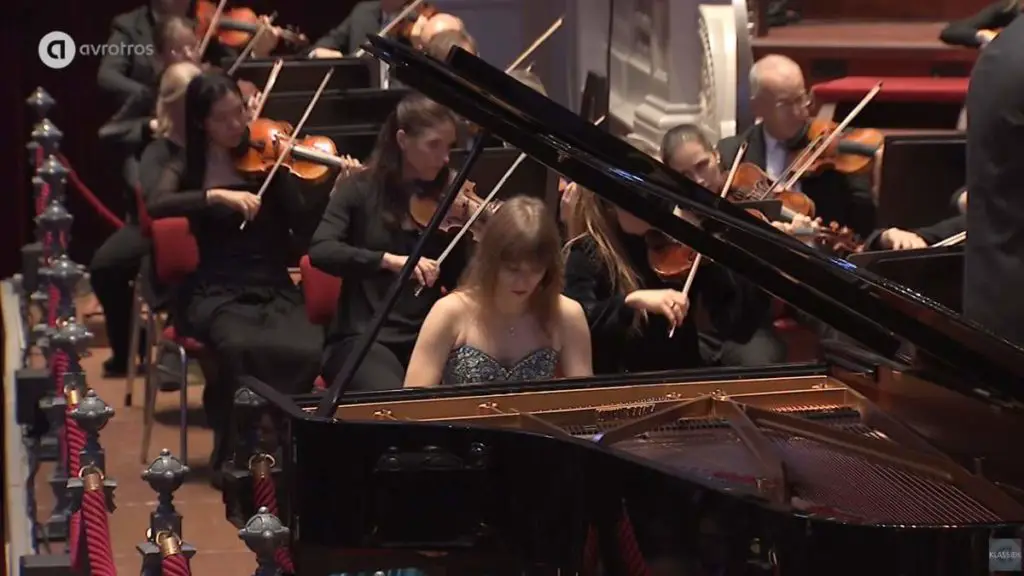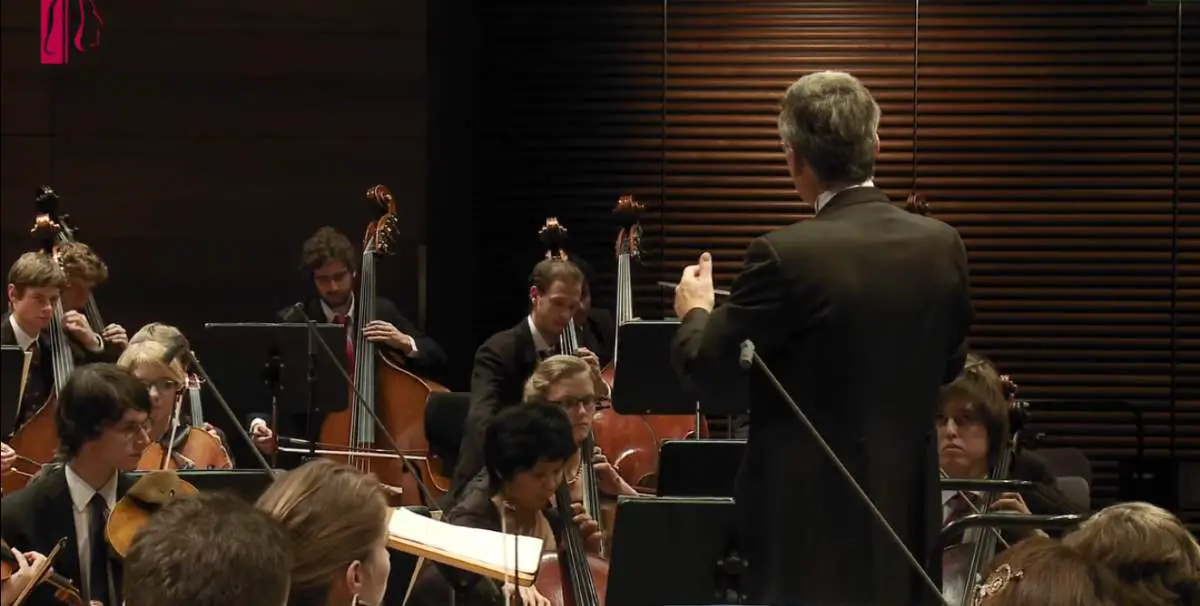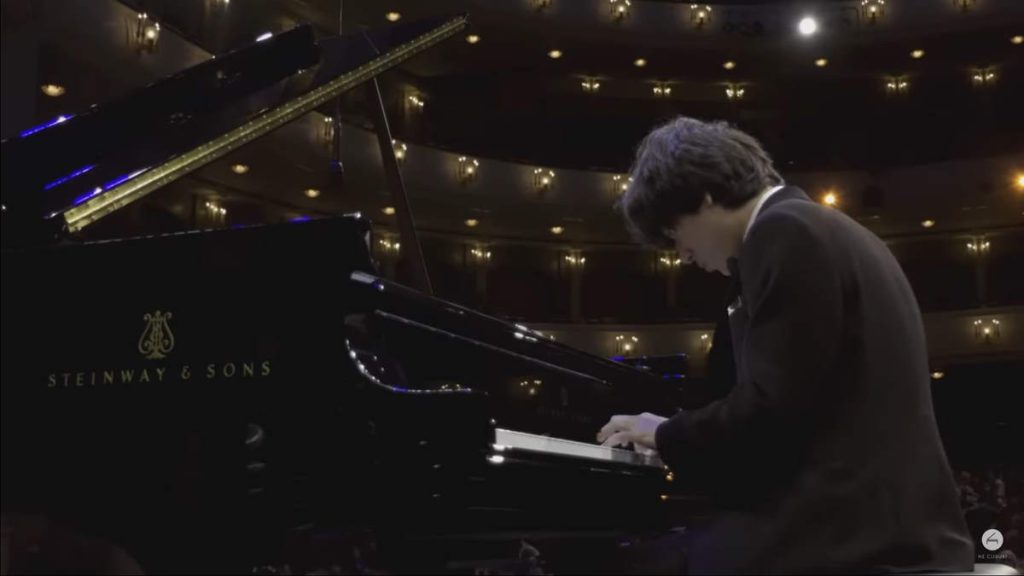Accompanied by the hr-Sinfonieorchester (Frankfurt Radio Symphony Orchestra), the young Russian pianist Alexander Malofeev (b. 2001) performs Sergei Rachmaninoff’s Piano Concerto No. 3 in D minor, Op. 30. In the second part of the concert, hr-Sinfonieorchester performs Nikolai Rimsky-Korsakov’s famous symphonic suite Scheherazade, Op. 35. Conductor: Alain Altinoglu. Recorded at the Alte Oper Frankfurt on September 15, 2022.
Sergei Rachmaninoff’s Piano Concerto No. 3
Composed in 1909, the work is widely regarded as one of the most technically challenging piano concertos in the standard classical repertoire.
The concerto is scored for 2 flutes, 2 oboes, 2 clarinets, 2 bassoons, 4 horns, 2 trumpets, 3 trombones, tuba, timpani, bass drum, snare drum, cymbals, piano, and strings. It is in three movements:
- Allegro ma non-tanto (D minor): The first movement revolves around a diatonic melody that soon develops into complex pianistic figuration. The second theme opens with quiet exchanges between the orchestra and the piano before fully diving into a slower theme in a major key. The first part of the first theme is restated before the movement is pulled into a loud development section which opens with toccata-like quavers in the piano and reaches a loud chordal section. The whole development exhibits features similar to a canon, such as an eighth note passage in the piano in which the left hand and the right hand play overlapping figures. The movement reaches a number of ferocious climaxes, especially in the cadenza. Rachmaninoff wrote two versions of this cadenza: the chordal original, which is commonly notated as the ossia, and a second one with a lighter, toccata-like style. Both cadenzas lead into a quiet solo section where the flute, clarinet, and horn restate the first theme of the exposition, accompanied by delicate arpeggios in the piano. The cadenza then ends quietly, but the piano alone continues to play a quiet development of the exposition’s second theme before leading to the recapitulation, where the first theme is restated by the piano, with the orchestra accompanying, soon closing with a quiet, rippling coda reminiscent of the second theme.
- Intermezzo: Adagio (F sharp minor/D flat major): The second movement is opened by the orchestra and it consists of a number of variations around a single lush, heavily romantic melody following one another without a rigid scheme. The melody soon moves to the tonic major which is the second theme. After the first theme development and recapitulation of the second theme, the main melody from the first movement reappears, before the movement is closed by the orchestra in a manner similar to the introduction. Then the piano gets the last word with a short “cadenza-esque” passage which moves into the last movement without pause. Many melodic thoughts of this movement allude to Rachmaninoff’s second piano concerto, third movement, noticeably the Russian-like, E-flat major melody.
- Finale: Alla breve (D minor → D major): The finale of Rachmaninoff’s Piano Concerto No. 3 is quick and vigorous and contains variations on many of the themes that are used in the first movement, which unites the concerto cyclically. However, after the first and second themes, it diverges from the regular sonata-allegro form. There is no conventional development; that segment is replaced by a lengthy digression using the major key of the third movement’s first theme, which leads to the two themes from the first movement. After the digression, the movement recapitulation returns to the original themes, building up to a toccata climax somewhat similar but lighter than the first movement’s ossia cadenza and accompanied by the orchestra. The movement concludes with a triumphant and passionate second theme melody in D major. The piece ends with the same four-note rhythm – claimed by some to be the composer’s musical signature – as the composer’s second concerto.
Nikolai Rimsky-Korsakov’s Scheherazade
Rimsky-Korsakov’s Scheherazade
Nikolai Andreyevich Rimsky-Korsakov was a master of orchestration. Based on One Thousand and One Nights (a collection of West and South Asian stories and folk tales compiled in Arabic during the Islamic Golden Age, it is often known in English as the Arabian Nights), Scheherazade is one of his best-known orchestral compositions.
The composer wrote a brief introduction that he intended for use with the score as well as the program for the premiere:
“The Sultan Schariar, convinced that all women are false and faithless, vowed to put to death each of his wives after the first nuptial night. But the Sultana Scheherazade saved her life by entertaining her lord with fascinating tales, told seriatim, for a thousand and one nights. The Sultan, consumed with curiosity, postponed from day to day the execution of his wife, and finally repudiated his bloody vow entirely.”
“The unison phrase, as though depicting Scheherazade’s stern spouse, at the beginning of the suite appears as a datum, in the Kalendar’s Narrative, where there cannot, however, be any mention of Sultan Shahriar. In this manner, developing quite freely the musical data taken as a basis of composition, I had to view the creation of an orchestral suite in four movements, closely knit by the community of its themes and motives, yet presenting, as it were, a kaleidoscope of fairy-tale images and designs of Oriental character.”
Movements
1. The Sea and Sinbad’s Ship (Largo e maestoso – Lento – Allegro non troppo – Tranquillo)
This movement is composed of various melodies and contains a general A B C A1 B C1 form. Although each section is highly distinctive, aspects of melodic figures carry through and unite them into a movement. Although similar in form to the classical symphony, the movement is more similar to the variety of motives used in one of Rimsky-Korsakov’s previous works Antar. Antar, however, used genuine Arabic melodies as opposed to Rimsky-Korsakov’s own ideas of an oriental flavor.
2. The Kalendar Prince (Lento – Andantino – Allegro molto – Vivace scherzando – Moderato assai – Allegro molto ed animato)
This movement follows a type of ternary theme and variation and is described as a fantastic narrative. The variations only change by virtue of the accompaniment, highlighting the piece’s “Rimsky-ness” in the sense of simple musical lines allowing for greater appreciation of the orchestral clarity and brightness. Inside the general melodic line, a fast section highlights changes within both tonality and structure of the fanfare motif, played by trombone and muted trumpet.
3. The Young Prince and The Young Princess (Andantino quasi allegretto – Pochissimo più mosso – Come prima – Pochissimo più animato)
This movement is also ternary and is considered the simplest movement in form and melodic content. The inner section is said to be based on the theme from Tamara, while the outer sections have song-like melodic content. The outer themes are related to the inner by tempo and common motif, and the whole movement is finished by a quick coda return to the inner motif, balancing it out nicely.
4. Festival at Baghdad. The Sea. The Ship Breaks against a Cliff Surmounted by a Bronze Horseman. (Allegro molto – Lento – Vivo – Allegro non troppo e maestoso – Tempo come I)
This movement ties in aspects of all the proceeding movements as well as adding some new ideas Including but not limited to: an introduction of both the beginning of the movement and the Vivace section based on Sultan Shakhriar’s theme, a repeat of the main Sheherazade violin theme, and a reiteration of the fanfare motif to portray the shipwreck. Coherence is maintained by the ordered repetition of melodies and continues the impression of a symphonic suite, rather than separate movements. A final conflicting relationship of the subdominant minor Shakhriar theme to the tonic major cadence of the Scheherazade theme resolves in a fantastic, lyrical, and finally peaceful conclusion.
Alexander Malofeev

Young Russian pianist Alexander Malofeev (born 21 October 2001 in Moscow) graduated with honors from the N. P. Osipov Children’s Music School in 2014.
He continued his studies with Elena Berezkina, who has the honorary title, “Honoured Cultural Worker of the Russian Federation”, at the Gnessin State Musical College in Moscow, graduating in 2019.
He gained international recognition at the 8th International Tchaikovsky Competition for Young Musicians held in Moscow in 2014, where he won first prize and the Gold Medal. Two years later, he was awarded the Grand Prix at the 1st Grand Piano Competition – International Competition for Young Pianists in Moscow.
In 2019, he won second prize and silver medal at the 1st China International Music Competition. He is also the recipient of numerous other international prizes. At the opening of the International Piano Festival of Brescia and Bergamo in April 2017 in Italy, he was awarded the “Premio Giovane Talento Musicale dell’anno 2017” (Best Young Musician of 2017).
Sources
- Piano Concerto No. 3 (Rachmaninoff) on Wikipedia
- Rachmaninov – Piano Concerto No. 3 in D minor on classicfm.com
- Concerto for Piano and Orchestra No. 3 in D minor, Op. 30 on classical.net
- Nikolai Rimsky-Korsakov on Wikipedia
- Scheherazade (Rimsky-Korsakov) on Wikipedia
- “1,001 Nights: A Guide to Rimsky-Korsakov’s Scheherazade” on the Houston Symphony website
- “Rimsky-Korsakov: Scheherazade, Symphonic Suite, Opus 35” on the San Francisco Symphony website
- Alexander Malofeev on Wikipedia




